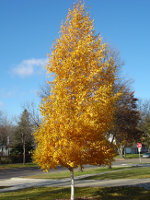Mon-Fri 9am - 5pm Mountain time
Dakota Pinnacle Birch vs Manchurian Walnut
Betula platyphylla fargo
Juglans mandshurica
CUSTOM GROW
NOT AVAILABLE THIS SEASON - MIGHT RETURN
Dakota Pinnacle Birch is a hardy deciduous tree with a columnar to narrowly pyramidal form. It makes a beautiful accent tree, and Dakota Pinnacle Birch is insect resistant and drought tolerant.
Dakota Pinnacle Birch features smooth white bark and dark, green foliage that turns yellow in the fall.
Manchurian Walnut is a large, broad and often multi-stemmed tree with ornamental qualities. This tree produces large, thick-shelled nuts that ripen in the fall. These edible walnuts are reportedly difficult to crack open. They are useful for attracting wildlife, especially squirrels.
The Manchurian Walnut contains and exudes much lesser quantities of allelopathic compounds, such as juglone (common to walnuts), that may prevent or impair growth of nearby plants. Therefore, it is commonly embraced as a safe walnut to plant.
There are reports of rare this species surviving winters to -45C with specimens growing and thriving in Alaska and Edmonton.
There is no regular supply of this species. It is rare and not produced each year.
Dakota Pinnacle Birch Quick Facts
Manchurian Walnut Quick Facts
In row spacing: 1.8 - 2.4 m (6 - 8 ft)

